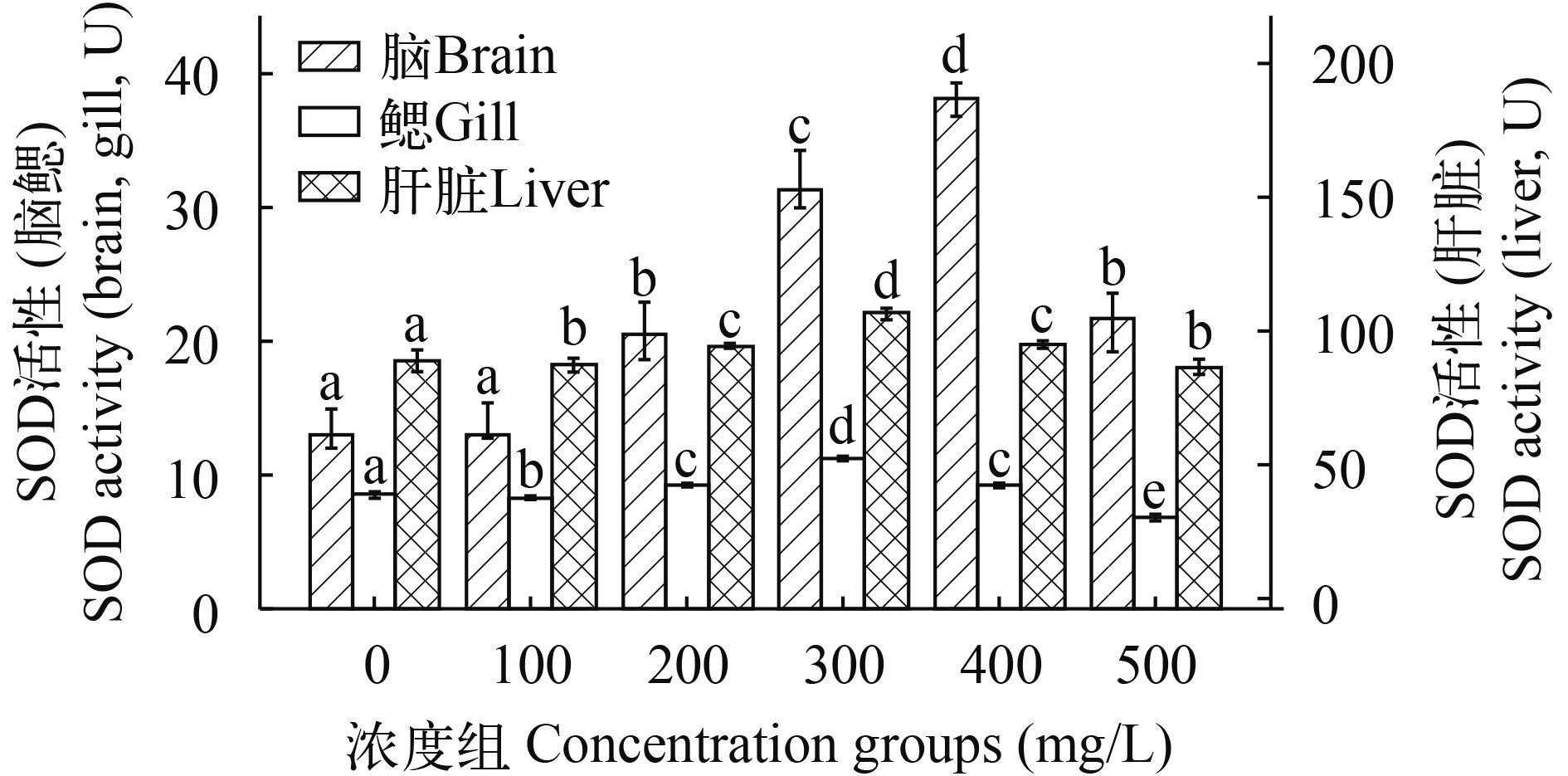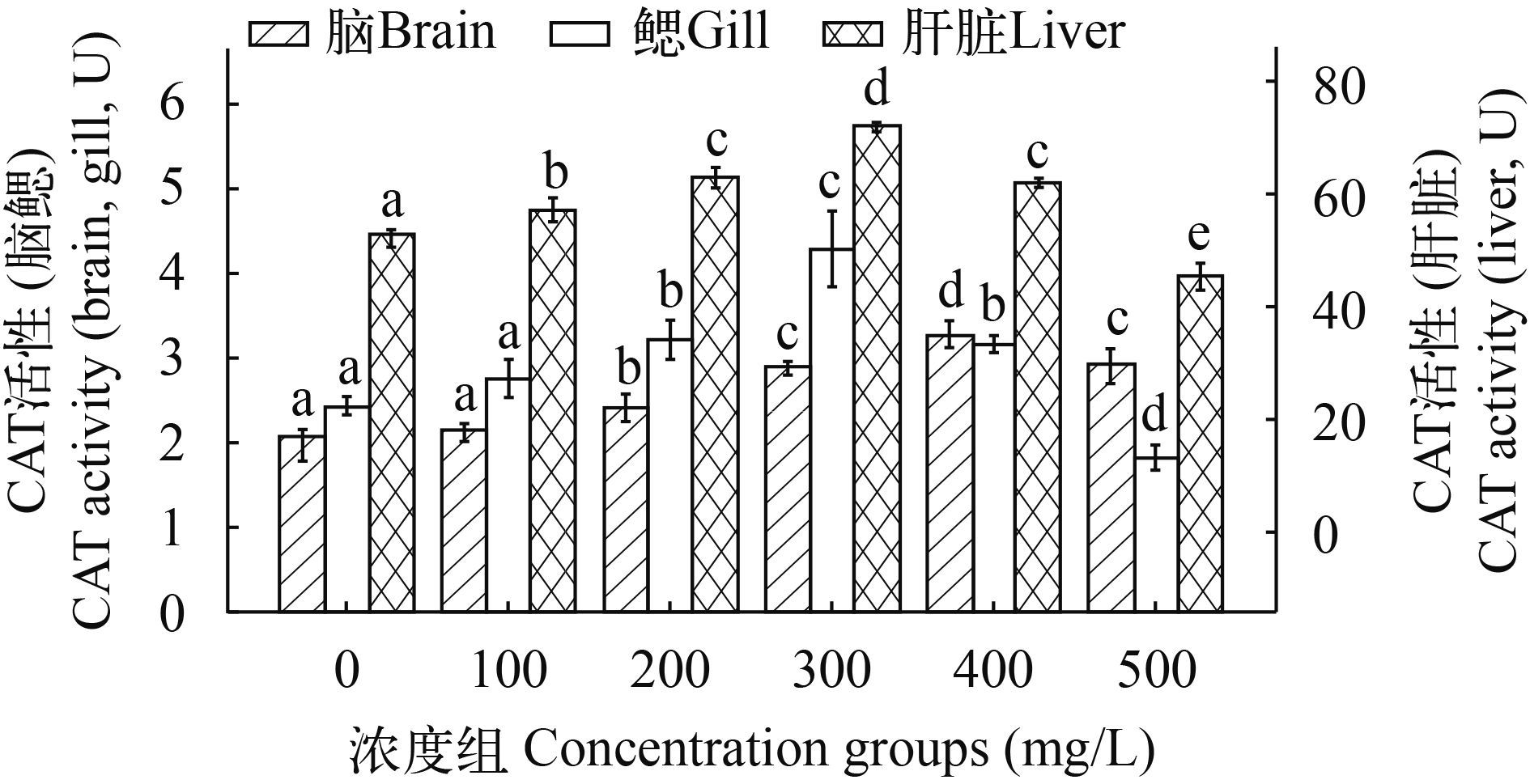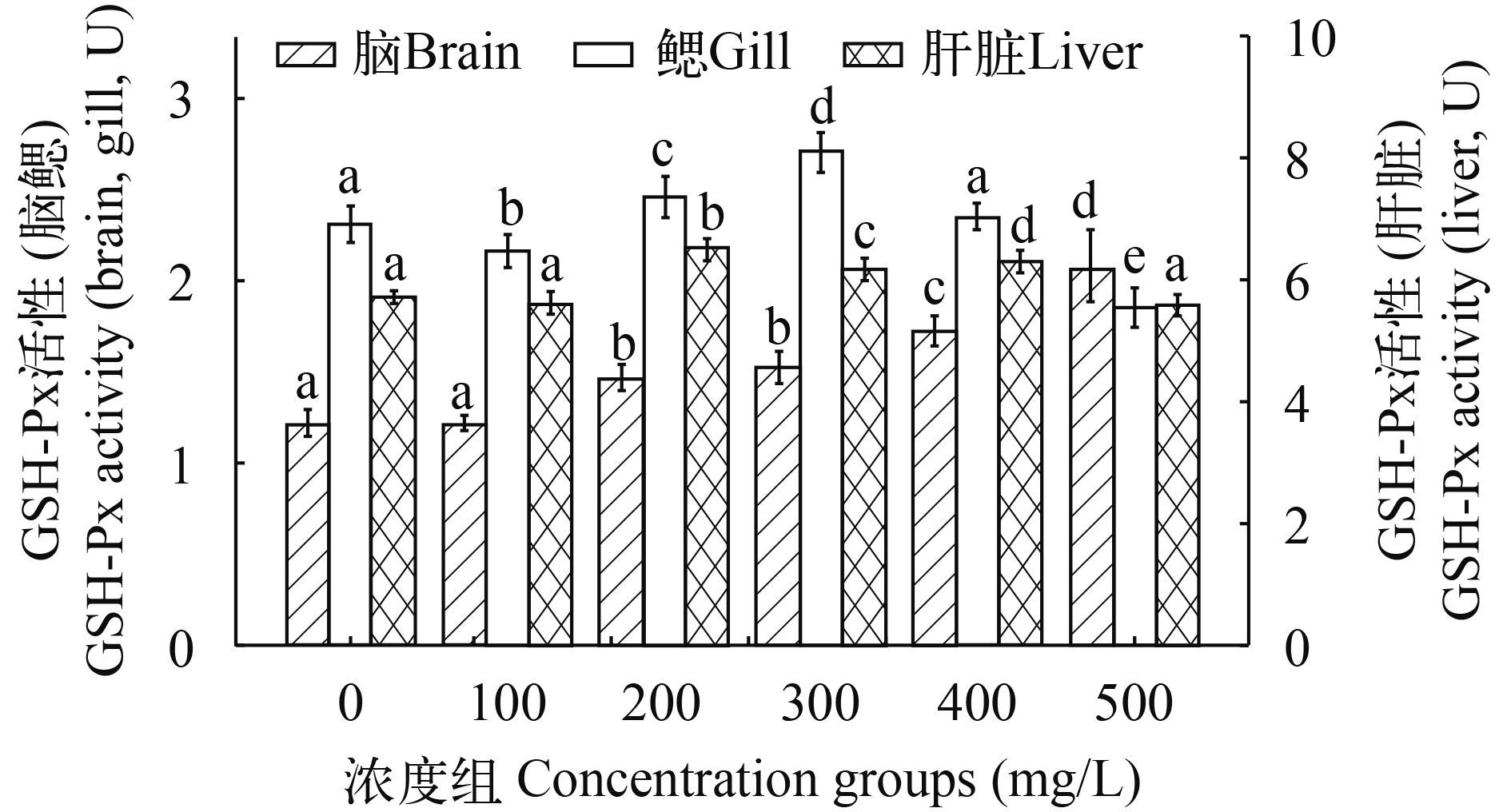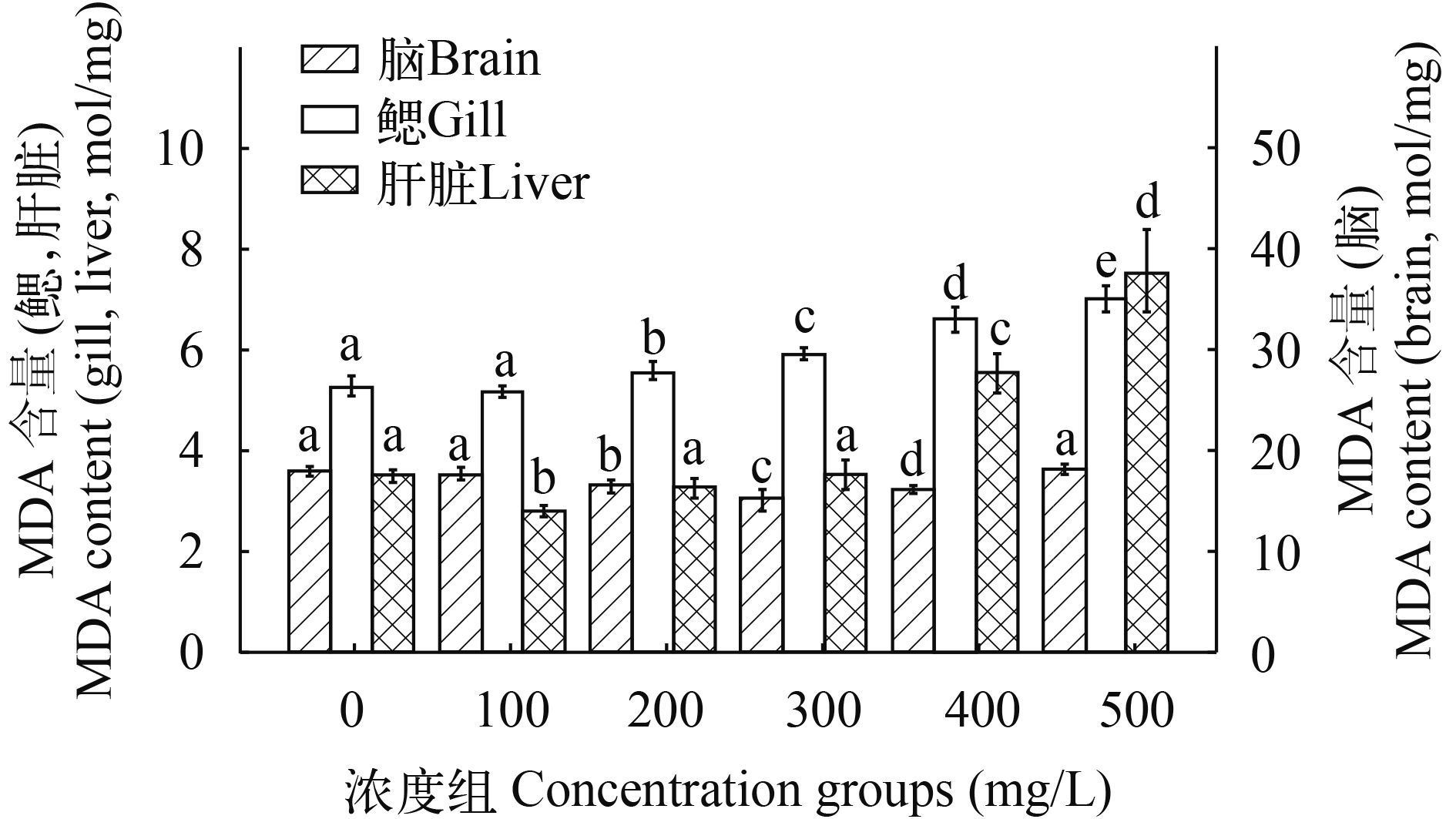PRELIMINARY STUDY OF THE ALIZARIN RED S EFFECT ON ANTIOXIDANT ENZYMES ACTIVITY AND LIPID PEROXIDATION OF SPINIBARBUS SINENSIS JUVENILES
-
摘要: 以中华倒刺鲃幼鱼[平均体长(12.3±0.6)cm,平均体重(41.8±3.6)g]为研究对象,通过测定不同浓度茜素红S溶液(ARS)浸泡24h后肝脏、脑和鳃组织中抗氧化酶(SOD、CAT、GSH-Px)的活性和丙二醛(MDA)含量,评估ARS对中华倒刺鲃幼鱼的生理生化影响。结果表明:除脑组织GSH-Px随着ARS浓度的升高而不断升高外,肝脏、鳃和脑组织的抗氧化酶活性均表现为低浓度被诱导而高浓度受抑制的规律,与ARS浓度呈抛物线型剂量效应关系。肝脏、鳃、脑组织抗氧化酶活性达到最大值所对应的浓度分别是300、300和400 mg/L。除鳃部MDA含量随着茜素红S浓度升高不断升高外,脑和肝脏组织的丙二醛含量随着ARS浓度的升高呈现出先降低后上升趋势。根据试验的结果,推荐120-200 mg/L为ARS染色标记中华倒刺鲃幼鱼(体长10 cm)的适宜浓度。Abstract: To assess the physiological and biochemical effect of Alizarin red S (ARS) on Spinibarbus sinensis juveniles, antioxidant enzymes (SOD, CAT, GSH-Px) activity and malondialdehyde (MDA) content of liver, brain and gill tissue were detected after 24h treatment in ARS. The results showed that brain GSH-Px activity increased continuously with rising concentration of ARS, other antioxidant enzymes activities in brain and antioxidant enzymes activities in both gill and liver were increased firstly and then decreased, which showed a parabolic dose-response relationship with the ARS concentration. Antioxidant enzyme activity in liver, gills and brain reached to the maximum at the concentration of 300, 300 and 400 mg/L, respectively. The MDA content of brain and liver firstly decreased and then increased with the rising concentration of ARS, but gill MDA content was increased continuously. These results suggest 120-200 mg/L of ARS for marking S. sinensis juveniles.
-
Keywords:
- Alizarin red S /
- Spinibarbus sinensis /
- Antioxidant enzyme /
- Malondialdehyde
-
中华倒刺鲃(Spinibarbus sinensis),俗称乌鳞、青波,隶属鲤形目(Cypriniformes)、鲤科(Cyprini- dae)、鲃亚科(Barbinae)、倒刺鲃属(Spinibarbus)。主要分布于长江上游水系,为长江上游主要的经济鱼类之一[1]。具有个体大,生长快,食性杂,抗病能力强,肉质肥嫩等特点[2]。近年来,由于过度捕捞及栖息地质量退化,自然种群资源量日趋枯竭[3]。为维持和恢复中华倒刺鲃的自然资源,近年来,在长江上游开展了多次增殖放流活动。据不完全统计,2011-2015年,在万州、宜宾、赤水等江段放流全长8-10 cm中华倒刺鲃幼鱼超过50万尾(吴金明等,未发表数据)。对增殖放流的中华倒刺鲃幼鱼进行标记,有助于科学评估人工增殖放流效果。由于放流的苗种数量多且苗种规格较小,在实际操作中一般采用茜素红S (alizarin red S,ARS)溶液(100-200 mg/L)染色进行批量标志。茜素红S为荧光染料的一种,能与鱼体组织中的钙结合而形成颜色标记,具有操作简便、节省成本等特点[4]。
荧光染料作为外源物质进入鱼体,势必会对鱼类的生理生化产生影响。当外源物质进入鱼体后,体内会产生大量活性氧(O2–·、·OH、H2O2),体内活性氧积累过多会对生物体造成氧化损伤,导致机体DNA断裂、脂质过氧化等[5],丙二醛(MDA)是膜脂质过氧化作用的产物之一,丙二醛的含量水平可反映细胞脂质过氧化程度[6, 7]。同时,生物体为防止过量活性氧所造成的伤害和保持其内环境的平衡,体内的抗氧化酶系统会对活性氧自由基进行清除,以达到抵御氧化损伤的目的。主要的抗氧化酶包括超氧化物歧化酶(SOD)、过氧化氢酶(CAT)、谷胱甘肽过氧化物酶(GSH-Px)等[8, 9]。通过检测鱼体组织(脑、肝脏、鳃等)中抗氧化酶活性和丙二醛(MDA)含量可评估外源性物质对鱼体生理生化的影响。因此,本研究采用抗氧化酶活性及丙二醛含量指标研究不同浓度ARS浸泡染色对中华倒刺鲃幼鱼生理生化的影响,以期掌握染色标记的安全浓度,为开展中华倒刺鲃的标记放流提供科学参考。
1. 材料与方法
1.1 实验材料
中华倒刺鲃幼鱼购于重庆合川区三江养殖场,运至长江水产研究所(武汉)暂养,两周后挑选体质健壮、规格均匀、反应灵敏的个体用于实验,暂养期间每日以正大幼鱼饲料(粗蛋白>30%,粗脂肪4%,粗纤维<10%,粗灰分<15%,水分<13%)早晚各投喂1次。在进行正式实验之前停食24h。随机抽取20尾中华倒刺鲃幼鱼测得其体长(12.3±0.6) cm,体重(41.8±3.6) g。
1.2 试验条件
试验所用的ARS(C14H7NaO7S,分子量: 342.26,分析纯,国药集团化学试剂有限公司)首先配成1000 mg/L的母液,预实验及正式实验时稀释成相应的质量浓度。试验在透明钢化水族箱中进行(长38 cm×宽23 cm×高26 cm),采用便携式多参数水质分析仪(YSI-ADV6600)对pH、温度、溶氧、氨氮、硬度等水质参数进行监测。实验用水为净水器处理后再曝气1d的自来水。所有的水族箱在实验期间充分曝气,在自然光下进行。实验期间不换水,不投饵,测得实验水体温度(22±0.5)℃,pH 7.2-7.8,溶氧量7.5-9.6 mg/L,硬度(20±3) mg CaCO3/L,总氨氮<0.01 mg/L。
1.3 实验方法
为确定药液质量浓度大致范围,预实验设定0、100、300、500、700和1000 mg/L共6个浓度组,每个浓度组放12尾中华倒刺鲃幼鱼,观察24h,确定不引起死亡的ARS最大浓度和100%致死质量浓度。预实验结果表明,0、100、200、300和500 mg/L浓度组的死亡率为0,700 mg/L浓度的死亡率为16.7%,1000 mg/L浓度组的死亡率为100%。正式实验在0 对照组和最大耐受质量浓度之间按等差数列设置6个ARS质量浓度组,分别为: 0、100、200、300、400 和500 mg/L。各浓度组设3个平行组,每组浓度投放10尾中华倒刺鲃幼鱼,浸泡24h后,在各浓度组中分别随机取3尾中华倒刺鲃幼鱼,经过200 mg/LMS-222麻醉后,迅速取出相应的脑、鳃、肝脏组织并放入5 mL塑料离心管中,置–20℃冰箱保存,测定不同浓度处理组中华倒刺鲃幼鱼不同组织的SOD、CAT、GSH-Px活性和MDA含量。
1.4 组织匀浆的制备及酶活性的测定
用预冷的生理盐水漂洗去血液,剪去肝脏表面附着的结缔组织,再用滤纸吸去表面水分,称取适量的样品,按质量:体积=1:10加入4℃预冷的生理盐水,在冰浴条件下,用超声波进行匀浆。匀浆液用冷冻离心机在4000 r/min下离心10min,取上清液备用。
样品上清液中蛋白含量的测定采用考马斯亮蓝比色法,SOD测定采用黄嘌呤氧化法改进的方法--羟胺法,CAT测定采用一般分光光度法,GSH-Px测定采用5,5′-二硫代硝基苯甲酸(DTNB)比色法,丙二醛(MDA)测定采用TBA法,试剂盒均购自南京建成生物工程研究所,操作按试剂盒说明进行。SOD活性单位定义为每毫克组织蛋白在1 mL反应液中,SOD抑制率达到50%时所对应的SOD量为1个活性单位(U); GSH-Px活性单位定义为每毫克组织蛋白,每分钟扣除非酶反应的作用,使反应体系中GSH浓度降低1 μmol/L为1个酶活性单位(U); CAT酶活性单位定义为每毫克组织蛋白每秒分解浓度降低1 μmol的H2O2的量为1个活性单位(U)。
1.5 数据处理
实验所得数据首先录入Excel 2007表格,然后通过SPSS 17.0软件进行单因素方差分析(one-way ANOVA)和Duncan多重比较(P<0.05表示差异显著)。采用SPSS 17.0软件作图。
2. 结果
2.1 脑组织抗氧化酶的活性
不同浓度浸泡中华倒刺鲃幼鱼,其脑组织中SOD酶和CAT酶的活性随着浸泡浓度的升高先升后降(图 1、图 2),当ARS浓度为400 mg/L时,SOD酶和CAT酶的活性达到最大值,分别为(38.16±0.52)和(3.27±0.07) U。虽然100 mg/L浓度组与对照组无显著性差异,但其他浓度组的酶活性均显著高于对照组(P<0.05)。除100 mg/L浓度组GSH-Px酶活性与对照组无显著性差异外,其他浓度组均显著高于对照组(P<0.05),且表现出随着浸泡浓度升高而持续升高的趋势(图 3)。总体而言,ARS对中华倒刺鲃幼鱼脑组织SOD、CAT、GSH-Px酶活性表现出诱导的作用。
2.2 鳃组织抗氧化酶的活性
随着ARS浓度的升高,鳃组织SOD酶活性趋势表现为先降低后升高再降低的趋势(图 1),当ARS浓度为300 mg/L时,SOD酶活性达到最大值(11.30±0.10) U,显著高于对照组(8.61±0.05) U (P<0.05),100和500 mg/L浓度组中,SOD酶活性显著低于对照组(P<0.05),表现为抑制作用,其他浓度组的SOD酶活性显著高于对照组(P<0.05),表现为诱导作用。鳃组织CAT酶活性随着ARS浓度升高表现为先升高后降低的趋势(图 2)。当ARS浓度达300 mg/L时,CAT酶活性达到最大值(4.29±0.18) U,显著高于对照组(2.44±0.05) U (P<0.05),除500 mg/L浓度组CAT显著低于对照组(P<0.05),表现为抑制作用外,其他浓度组均显著高于对照组(P<0.05),表现为诱导作用。鳃组织GSH-Px酶活性的检测结果显示(图 3),200和300 mg/L浓度组显著高于对照组(P<0.05),表现为诱导作用,400 mg/L与对照组无显著性差异(P>0.05),而100和500 mg/L浓度组显著低于对照组(P<0.05),表现为抑制作用。
2.3 肝脏组织抗氧化酶的活性
当ARS浓度达300 mg/L时,肝脏内SOD酶活性达到最大值(110.39±0.90) U,显著高于对照组(93.12±1.50) U (P<0.05),100和500 mg/L浓度组的SOD酶活性显著低于对照组(P<0.05),表现为抑制作用,其他浓度组SOD酶活性显著高于对照组(P<0.05)(图 1)。肝脏组织CAT酶活性随着ARS浓度升高表现为先升高后降低的趋势(图 2)。当ARS浓度为300 mg/L时,CAT酶活性达到最大值(86.00±0.34) U,显著高于对照组(66.95±0.33) U (P<0.05),除500 mg/L浓度组CAT显著低于对照组(P<0.05),表现为抑制作用外,其他浓度组均显著高于对照组(P<0.05),表现为诱导作用。肝脏组织GSH-Px酶活性变化趋势无规律性(图 3)。200、300和400 mg/L浓度组GSH-Px酶活性显著高于对照组(P<0.05),表现为诱导作用,而100和500 mg/L浓度组GSH-Px酶活性无显著性差异(P>0.05)。
2.4 各组织中丙二醛(MDA)的含量
不同浓度ARS浸泡24h后,中华倒刺鲃幼鱼不同组织MDA含量的变化如图 4所示: 随着ARS浓度不断升高,脑组织MDA含量变化趋势是先降低后升高,200、300和400 mg/L浓度组显著低于对照组(P<0.05),而100和500 mg/L浓度组的MDA含量与对照组无显著性差异(P>0.05)。鳃组织中MDA含量随ARS浓度的升高持续升高,除100 mg/L浓度组与对照组无显著性差异外(P>0.05),其他浓度组MDA含量都显著高于对照组(P<0.05)。肝脏组织中MDA含量随着浸泡浓度的升高先下降后上升,100 mg/L浓度组显著低于对照组(P<0.05),200和300 mg/L浓度组与对照组无显著性差异(P>0.05),400和500 mg/L浓度组显著高于对照组(P<0.05)。
3. 讨论
3.1 ARS对中华倒刺鲃幼鱼不同组织抗氧化酶系统的影响
抗氧化酶的变化通常被用作机体受到外源有机污染物暴露胁迫时的早期指示信号[10]。鱼体中最主要的抗氧化保护来源于SOD、CAT以及GSH-Px等抗氧化酶,这些酶能维持胞内超氧阴离子(O2–·)和过氧化氢(H2O2)水平的稳定[11, 12]。
SOD和CAT是清除活性氧自由基的重要酶蛋白,对机体细胞损伤后的氧化过程和吞噬作用具有很强的防御功能。通常认为: SOD在清除活性氧的过程中最早发挥作用,它首先促使O2–·歧化为H2O2和H2O,随后CAT再将H2O2催化为H2O和O2,从而达到为机体解毒的目的[13],在本实验中,ARS浸泡胁迫下中华倒刺鲃幼鱼肝脏、鳃、脑组织SOD、CAT活性变化趋势大致相同,都呈先升高再降低的变化规律,表现出毒性实验中较常见的抛物线型剂量效应关系。即低浓度ARS对抗氧化酶起诱导作用,而高浓度ARS对抗氧化酶起抑制作用。这与王凡等[14]、胡蓉等[15]分别对牙鲆(Paralichthys olivaceus)和鲫(Carassius auratus)的抗氧化酶研究结果一致。例外的是,100 mg/L浓度组的肝脏和鳃中SOD活性显著低于对照组,可能是鱼体处于氧化应激状态,机体的代谢增强,产生较多活性氧,机体通过消耗一部分SOD来防止活性氧在体内的积累,致使SOD含量暂时降低。当ARS浓度增加时,肝脏和鳃组织的SOD和CAT活性开始受到诱导,明显升高。毒物在低浓度下所出现的增益是其在无毒情况下的刺激反应,被Stebbing[16]称为“毒物兴奋效应”。500 mg/L浓度组的鳃和肝脏中的SOD和CAT明显受到抑制,出现“毒物抑制效应”。从不同组织抗氧化酶CAT和SOD活性测定结果来看,500 mg/L浓度组时,幼鱼的肝脏,鳃组织已受到损伤,而脑组织暂时未受到损伤。
GSH-Px是机体内广泛存在的一种重要的过氧化物分解酶,在消除细胞中过氧化氢方面具有与CAT相似的能力[17]。经ARS浸泡,肝脏组织和鳃组织GSH-Px活性随着浓度提高整体呈现先升高后降低的趋势,出现“低促高抑”规律。与赵鹏等[18]关于钙黄绿素对刺参抗氧化酶研究结果一致。而脑组织GSH-Px活性随着浓度提高呈现不断升高趋势,可能是脑组织对ARS的耐受度比较高,未超过脑组织的阈值。100 mg/L浓度组时,鳃组织的GSH-Px活性低于对照组,可能是由于SOD催化氧自由基生成较多的过氧化氢消耗掉大量的GSH-Px致使其活性降低。而肝组织GSH-Px活性在300 mg/L浓度组中有小幅度回落,可能与肝脏中抗氧化酶系统中不同氧化酶发挥作用的阶段不同相关,与肝脏中CAT产生一定的竞争作用导致的,其详细的生理过程需要进一步的研究。
3.2 ARS对中华倒刺鲃幼鱼不同组织脂质过氧化的影响
丙二醛(MDA)是一种高活性的脂质过氧化产物,其体积质量分数的变化既可用作脂质过氧化程度的衡量指标,也可间接反映机体内活性氧的累计[19]。在本研究中,MDA的含量在不同组织中具有较大差异,从大到小依次为脑、鳃、肝脏,这种组织特异性可能与器官组织执行的生理功能和代谢水平有关。在本研究中,肝脏和脑组织中的MDA含量随着ARS浓度升高均表现出先降低再升高的趋势。其原因在于鱼体处于低浓度组时,机体不同组织处于氧化应激状态,刺激机体抗氧化酶系统产生足够多SOD、CAT、GSH-Px抗氧化酶来消除氧自由基,减轻脂质过氧化作用,导致机体MDA的含量降低,当ARS浓度超过机体能承受的范围之后,机体会因为过量的氧自由基产生,加剧脂质过氧化,进而使细胞膜膜结构和功能遭受破坏,MDA含量迅速升高,这种“低抑高促”效应与汪承润等[20]研究结果一致。鳃组织中的MDA含量在100 mg/L时与对照组无显著性差异,但随着浸泡浓度升高而持续升高,这也表现出鳃组织的敏感性,依据最低可观察效应质量浓度(LOEC),本实验中肝脏、脑、鳃组织MDA的LOEC分别是400、>500和200 mg/L。
3.3 ARS对中华倒刺鲃幼鱼浸泡标记的合理浓度
谭树华等[18]指出抛物线顶点所对应的污染浓度可认为是生物对此污染物的耐受阈值,超过了这个耐受阈值,相应酶活性就开始降低,也是生物发生中毒反应的前兆[19]。由于组织特异性和敏感性不同,中华倒刺鲃幼鱼各组织的耐受阈值并不相同。根据本研究的结果,脑、鳃和肝脏组织中SOD和CAT活性顶点对应的浓度分别为400、300和300 mg/L,GSH-Px活性顶点对应的浓度分别为>500、300和200 mg/L,另外结合肝脏、脑、鳃组织MDA的LOEC情况,依据最低阈值原则,当浸泡浓度小于200 mg/L时,对鱼体抗氧化酶活性和脂质过氧化的影响较小。根据靳建波等[21]对秦岭细鳞鲑仔鱼浸泡效果的浓度推荐(120 mg/L)以及本研究预实验中对死亡率的观测,推荐10 cm左右的中华倒刺鲃幼鱼可使用120-200 mg/L的浓度进行染色标记。
-
-
[1] 张怡, 夏继刚, 曹振东, 等. 铜对中华倒刺鲃幼鱼的急性致毒效应. 重庆师范大学学报(自然科学版), 2013, 30(4):16-21 http://www.cnki.com.cn/Article/CJFDTOTAL-CQSF201304003.htm Zhang Y, Xia J G, Cao Z D, et al. Acute toxic of Cu2+ on juvenile qinggbo, Spinibarbus sinensis[J]. Journal of Chongqing Normal University (Natural Science), 2013, 30(4):16-21
张怡, 夏继刚, 曹振东, 等. 铜对中华倒刺鲃幼鱼的急性致毒效应. 重庆师范大学学报(自然科学版), 2013, 30(4):16-21 http://www.cnki.com.cn/Article/CJFDTOTAL-CQSF201304003.htm[2] 李萍, 王宝森. 中华倒刺鲃. 生物学通报, 2008, 43(8):17-18 Li P, Wang B S. Spinibarbus sinensis[J]. Bulletin of Biology, 2008, 43(8):17-18
李萍, 王宝森. 中华倒刺鲃. 生物学通报, 2008, 43(8):17-18[3] 徐薇, 乔晔, 龚昱田. 长江上游鱼类资源变迁及其保护评析. 人民长江, 2012, 43(1):67-71 http://www.cnki.com.cn/Article/CJFDTOTAL-RIVE201201021.htm Xu W, Qiao Y, Gong Y T. Changes of fish resources in upper Yangtze River and its protection[J]. Yangtze River, 2012, 43(1):67-71
徐薇, 乔晔, 龚昱田. 长江上游鱼类资源变迁及其保护评析. 人民长江, 2012, 43(1):67-71 http://www.cnki.com.cn/Article/CJFDTOTAL-RIVE201201021.htm[4] Vander Walt B, Faragher R A. Otolith marking of rainbow trout fry by immersion in low concentrations of alizarin complex one[J]. North American Journal of Fisheries Management, 2003, 23(1):141-148 doi: 10.1577/1548-8675(2003)023<0141:OMORTF>2.0.CO;2
[5] Silva A M M, Novelli E L B, Fascineli M L, et al. Impact of an environmentally realistic intake of water contaminants and superoxide formation on tissues of rats[J]. Environmental Pollution, 1999, 105(2):243-249 doi: 10.1016/S0269-7491(98)00213-9
[6] 魏建军, 张帆, 田文静, 等. 饲料中添加叶酸和VB12对中华绒螯蟹幼蟹生长、非特异性免疫和抗病力的影响. 水生生物学报, 2015, 39(6):1069-1075 http://ssswxb.ihb.ac.cn/CN/article/downloadArticleFile.do?attachType=PDF&id=3912 Wei J J, Zhang F, Tian W J, et al. The effects of dietary folic acid and vitamin B12 on the growth performance, non-specific immunity and the disease resistance of juvenile Chinese mitten carb Eriocheir sinensis[J]. Acta Hydrobiologica Sinica, 2015, 39(6):1069-1075
魏建军, 张帆, 田文静, 等. 饲料中添加叶酸和VB12对中华绒螯蟹幼蟹生长、非特异性免疫和抗病力的影响. 水生生物学报, 2015, 39(6):1069-1075 http://ssswxb.ihb.ac.cn/CN/article/downloadArticleFile.do?attachType=PDF&id=3912[7] 孙淑红, 焦传珍, 刘小林, 等. Cd (Ⅱ)对泥鳅抗氧化酶活性和脂质过氧化的影响. 大连水产学院学报, 2009, 24(1):52-56 http://www.cnki.com.cn/Article/CJFDTOTAL-DLSC200901012.htm Sun S H, Jiao C Z, Liu X L, et al. Effects of cadmium (Ⅱ) stress on xanthine oxidase and antionxidant enzyme activities in hepatopancreas of oriental weatherfish Misgumus anguillicaudatus[J]. Journal of Dalian Fisheries University, 2009, 24(1):52-56
孙淑红, 焦传珍, 刘小林, 等. Cd (Ⅱ)对泥鳅抗氧化酶活性和脂质过氧化的影响. 大连水产学院学报, 2009, 24(1):52-56 http://www.cnki.com.cn/Article/CJFDTOTAL-DLSC200901012.htm[8] Da Silva A Z, Zanette J, Ferreira J F, et al. Effects of salinity on biomarker responses in Crassostrea rhizophorae (Mollusca, Bivalvia) exposed to diesel oil[J]. Ecotoxicology and Environmental Safety, 2005, 62(3):376-382 doi: 10.1016/j.ecoenv.2004.12.008
[9] 邓思平, 赵云涛, 朱春华, 等. 镉对尖紫蛤抗氧化酶活性及脂质过氧化的影响. 水生生物学报, 2012, 36(4):689-695 http://ssswxb.ihb.ac.cn/EN/abstract/abstract2193.shtml Deng S P, Zhao Y T, Zhu C H, et al. Effect of cadmium on the antioxidant enzyme activity and lipid peroxidation in Sanguinolaria Acuta[J]. Acta Hydrobiologica Sinica, 2012, 36(4):689-695
邓思平, 赵云涛, 朱春华, 等. 镉对尖紫蛤抗氧化酶活性及脂质过氧化的影响. 水生生物学报, 2012, 36(4):689-695 http://ssswxb.ihb.ac.cn/EN/abstract/abstract2193.shtml[10] Davies K J A. Oxidative stress:the paradox of aerobic life[C]. Biochemical Society Symposia. Portland Press, London. 1995, 1-32
[11] Ferrante I, Ricci R, Aleo E, et al. Can enzymatic antioxidant defences in liver discriminate between wild and sea cage-reared Bluefin Tuna quality[J]? Aquaculture, 2008, 279(1):182-187 http://cn.bing.com/academic/profile?id=1963980127&encoded=0&v=paper_preview&mkt=zh-cn
[12] Mourente G, Diaz-Salvago E, Bell J G, et al. Increased activities of hepatic antioxidant defence enzymes in juvenile gilthead sea bream (Sparus aurata L.) fed dietary oxidised oil:attenuation by dietary vitamin E[J]. Aquaculture, 2002, 214(1):343-361 http://cn.bing.com/academic/profile?id=2066786074&encoded=0&v=paper_preview&mkt=zh-cn
[13] 张克烽, 张子平, 陈芸, 等. 动物抗氧化系统中主要抗氧化酶基因的研究进展. 动物学杂志, 2007, 42(2):153-160 http://www.cnki.com.cn/Article/CJFDTOTAL-BIRD200702035.htm Zhang K F, Zhang Z P, Chen Y, et al. Progress of the research on the main antioxidant enzyme gene in the antioxidant system of animal[J]. Chinese Journal of Zoology, 2007, 42(2):153-160
张克烽, 张子平, 陈芸, 等. 动物抗氧化系统中主要抗氧化酶基因的研究进展. 动物学杂志, 2007, 42(2):153-160 http://www.cnki.com.cn/Article/CJFDTOTAL-BIRD200702035.htm[14] 王凡, 赵元凤, 吕景才, 等. 铜对牙鲆CAT, SOD和GSH-Px活性的影响. 华中农业大学学报, 2008, 26(6):836-838 http://www.cnki.com.cn/Article/CJFDTOTAL-HZNY200706017.htm Wang F, Zhao Y F, Lü J C, et al. Effects of copper to the activity of CAT, SOD and GSH-Px in gram-negative[J]. Journal of Huazhong Agricultural University, 2008, 26(6):836-838
王凡, 赵元凤, 吕景才, 等. 铜对牙鲆CAT, SOD和GSH-Px活性的影响. 华中农业大学学报, 2008, 26(6):836-838 http://www.cnki.com.cn/Article/CJFDTOTAL-HZNY200706017.htm[15] 胡蓉, 唐正义. 镉对鲫鱼肝胰脏CAT和SOD活性的影响. 西南大学学报:自然科学版, 2011, 33(8):94-98 http://www.cnki.com.cn/Article/CJFDTOTAL-XNND201108019.htm Hu R, Tang Z Y, Effects of cadmium to the activity of CAT and SOD in liver pancreas for crucian carp[J]. Journal of Southwest Agricultural University, 2011, 33(8):94-98
胡蓉, 唐正义. 镉对鲫鱼肝胰脏CAT和SOD活性的影响. 西南大学学报:自然科学版, 2011, 33(8):94-98 http://www.cnki.com.cn/Article/CJFDTOTAL-XNND201108019.htm[16] Stebbing A R D. Hormesis-the stimulation of growth by low levels of inhibitors[J]. Science of the Total Environment, 1982, 22(3):213-234 doi: 10.1016/0048-9697(82)90066-3
[17] Dandapat J, Chainy G B N, Rao K J. Lipid peroxidation and antioxidant defence status during larval development and metamorphosis of giant prawn, Macrobrachium rosenbergii[J]. Comparative Biochemistry and Physiology Part C:Toxicology &Pharmacology, 2003, 135(3):221-233 http://cn.bing.com/academic/profile?id=2063564839&encoded=0&v=paper_preview&mkt=zh-cn
[18] 赵鹏, 杨红生, 王晓宇, 等. 钙黄绿素标记刺参的效果及其对刺参抗氧化酶活力的影响. 水产学报, 2011, 35(3):372-378 http://www.cnki.com.cn/Article/CJFDTOTAL-SCKX201103009.htm Zhao P, Yang H S, Wang X Y, et al. Marking sea cucumber Apostichopus japonicus with calcein and its effects on antioxidant system[J]. Journal of Fisheries of China, 2011, 35(3):372-378
赵鹏, 杨红生, 王晓宇, 等. 钙黄绿素标记刺参的效果及其对刺参抗氧化酶活力的影响. 水产学报, 2011, 35(3):372-378 http://www.cnki.com.cn/Article/CJFDTOTAL-SCKX201103009.htm[19] Scandalios J G. Oxygen stress and superoxide dismutases[J]. Plant Physiology, 1993, 101(1):7 doi: 10.1104/pp.101.1.7
[20] 孟范平, 于腾. 多溴联苯醚在海洋生物中的富集及毒性效应评述. 热带海洋学报, 2010, 29(5):1-9 http://www.cnki.com.cn/Article/CJFDTOTAL-RDHY201005002.htm Meng F P, Yu T. Review on bioaccumulation and toxicity of polybrominated diphenyl ethers in marine organisms[J]. Journal of Tropical Oceanography, 2010, 29(5):1-9
孟范平, 于腾. 多溴联苯醚在海洋生物中的富集及毒性效应评述. 热带海洋学报, 2010, 29(5):1-9 http://www.cnki.com.cn/Article/CJFDTOTAL-RDHY201005002.htm[21] 靳建波, 危起伟, 孙庆亮, 等. 茜素络合物浸泡标记秦岭细鳞鲑发眼卵及仔鱼耳石. 淡水渔业, 2011, 41(2):10-17 http://www.cnki.com.cn/Article/CJFDTOTAL-DSYY201102003.htm Jin J B, Wei Q W, Sun Q L, et al. Alizarin marking of otolith at eggs and larvae stages in Brachymystax lenok tsinlingensis[J]. Freshwater Fisheries, 2011, 41(2):10-17
靳建波, 危起伟, 孙庆亮, 等. 茜素络合物浸泡标记秦岭细鳞鲑发眼卵及仔鱼耳石. 淡水渔业, 2011, 41(2):10-17 http://www.cnki.com.cn/Article/CJFDTOTAL-DSYY201102003.htm -
期刊类型引用(9)
1. 董炜峰,杨毕铖,李光毅,戴红,刘志勇,蒋灏. 不同质量浓度HgCl_2对凡纳滨对虾的急性毒性评估. 水产科学. 2024(01): 97-103 .  百度学术
百度学术
2. 张建明,张德志,田甜,舒德斌. 植物多糖对长江鲟幼鱼不同组织抗氧化指标和免疫指标的影响及机理初探. 中国饲料. 2024(09): 96-106 .  百度学术
百度学术
3. 宋明波,呼德拉提·阿那斯,时春明,张人铭. 茜素红S对准噶尔雅罗鱼幼鱼的急性毒性与标记效果. 内蒙古农业大学学报(自然科学版). 2023(02): 1-6 .  百度学术
百度学术
4. 张建明,张德志,舒德斌,田甜,饶军,苏巍. 4种中药复方对长江鲟幼鱼抗氧化和抗应激指标的影响. 南方农业学报. 2022(02): 568-576 .  百度学术
百度学术
5. 白天泉,姚俊杰,毛茜,王礼节,罗永泉. 茜素红S对鲈鲤幼鱼肌肉抗氧化指标的影响. 水产学杂志. 2022(05): 76-81+91 .  百度学术
百度学术
6. 汪政希,吴彤飞,钟雪菲,王元贞,陈灵涵,付梅,姚维志,张志新,吕红健. 拌饲投喂钙黄绿素对中华倒刺鲃幼鱼不同组织抗氧化酶活性和脂质过氧化的影响. 水产学报. 2022(12): 2383-2395 .  百度学术
百度学术
7. 唐容,吕红健,付梅,苏胜齐,姚维志. 鱼类双重荧光标记研究——以中华倒刺鲃幼鱼为例. 水生生物学报. 2021(01): 29-38 .  本站查看
本站查看
8. 阙江龙,王生,万锦涛,李涵,贺刚,张燕萍. 茜素红S标记鳙耳石的效果及其在增殖放流中的应用. 水产学杂志. 2020(04): 59-63 .  百度学术
百度学术
9. 郭鹤,徐莉佳,叶勤,陶怡曦,苏英,吴荣华,李云. 盐酸四环素标记斑马鱼耳石效果及对抗氧化力的影响. 淡水渔业. 2019(02): 33-38 .  百度学术
百度学术
其他类型引用(4)




 下载:
下载:


